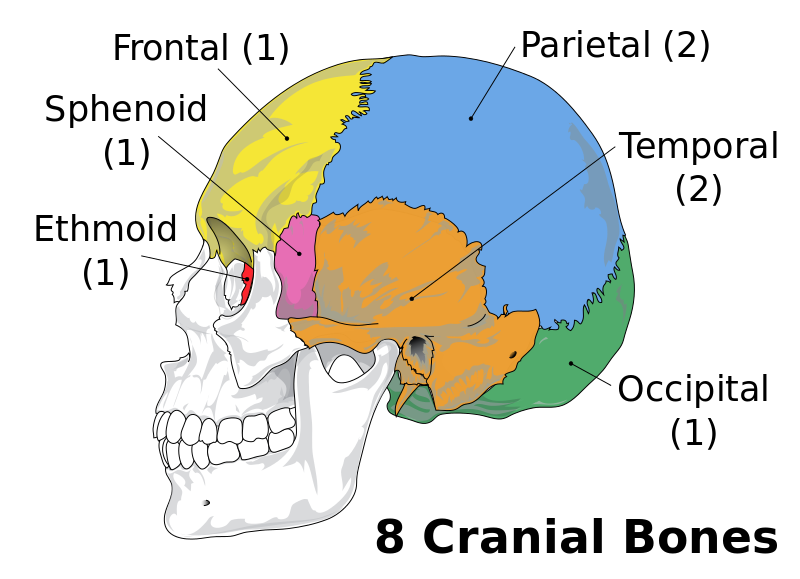Updated March 11, 2022
Eight cranial bones make up the cranium. The names of the cranial bones give away information on their location:
- two parietal bones (one on each side)
- occipital bone
- two temporal bones (one on each side)
- sphenoid bone
- ethmoid bone
See a colorized animation here.

The occipital bone is at the back and underside of the head, corresponding to the occipital lobe of the brain. The vertebral column passes through it, giving the spinal cord access to the brain. Ridges called the superior and inferior nuchal lines run along the occipital bone for muscle attachment, making the bone important for head movement, position, and stability.
Above the occipital bone, covering the top of the head, are the left and right parietal bones. Below the parietal bones, and attached to the occipital bone, are the left and right temporal bones. The lower jaw attaches to the temporal bones via the mandibular fossa. The ear canal enters through this bone at the tympanic and mastoid process. The zygomatic process of the temoral bone makes up part of the zygomatic arch, also known as the cheekbone. The area just in front of the ear is often called the temple.
The frontal bone makes up the front of the skull – the forehead and the upper eye and nasal cavities, extending back to the parietal bones. The superciliary arch forms the eyebrow arch. At the top of the nose between the eyes, the small elevation is called the glabella.
The ethmoid bone is a small spongy bone behind the nose and between the eyes. The sphenoid bone is another small bone, located the full width of the front of the skull and shaped like a butterfly. The wing-like processes fill a gap between the other cranial bones on the sides of the head where the temporal, parietal, and frontal bones meet (the temple). The pituitary gland is found in the sella turcica, a saddle-like structure in this bone’s central body.
Disclaimer: This page is for informational and learning purposes only. It is not meant to diagnose or treat any medical condition and should not be used in place of speaking with a medical doctor or seeking treatment.
Aliconia Publishing, LLC and the author make any and all attempts to ensure the accuracy of the presented facts. If you find an issue with any information on these pages, please use the Contact page to alert us. The content is subject to change based on new information or to be updated with additional facts. The date of last change is stated under the main header.
Discover more from Just Facts
Subscribe to get the latest posts sent to your email.